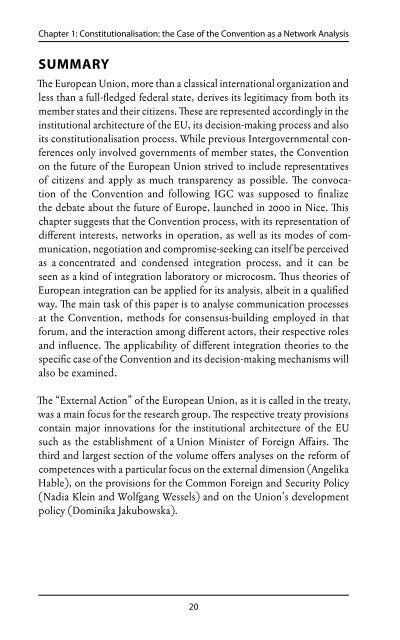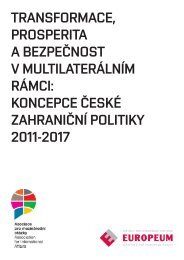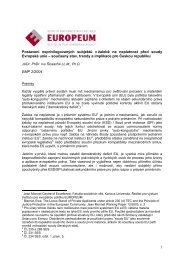eu constitutionalisation - EUROPEUM Institute for European Policy
eu constitutionalisation - EUROPEUM Institute for European Policy
eu constitutionalisation - EUROPEUM Institute for European Policy
You also want an ePaper? Increase the reach of your titles
YUMPU automatically turns print PDFs into web optimized ePapers that Google loves.
Chapter 1: Constitutionalisation: the Case of the Convention as a Network AnalysisSUMMARYThe <strong>European</strong> Union, more than a classical international organization andless than a full-fledged federal state, derives its legitimacy from both itsmember states and their citizens. These are represented accordingly in theinstitutional architecture of the EU, its decision-making process and alsoits <strong>constitutionalisation</strong> process. While previous Intergovernmental conferencesonly involved governments of member states, the Conventionon the future of the <strong>European</strong> Union strived to include representativesof citizens and apply as much transparency as possible. The convocationof the Convention and following IGC was supposed to finalizethe debate about the future of Europe, launched in 2000 in Nice. Thischapter suggests that the Convention process, with its representation ofdifferent interests, networks in operation, as well as its modes of communication,negotiation and compromise-seeking can itself be perceivedas a concentrated and condensed integration process, and it can beseen as a kind of integration laboratory or microcosm. Thus theories of<strong>European</strong> integration can be applied <strong>for</strong> its analysis, albeit in a qualifiedway. The main task of this paper is to analyse communication processesat the Convention, methods <strong>for</strong> consensus-building employed in that<strong>for</strong>um, and the interaction among different actors, their respective rolesand influence. The applicability of different integration theories to thespecific case of the Convention and its decision-making mechanisms willalso be examined.The “External Action” of the <strong>European</strong> Union, as it is called in the treaty,was a main focus <strong>for</strong> the research group. The respective treaty provisionscontain major innovations <strong>for</strong> the institutional architecture of the EUsuch as the establishment of a Union Minister of Foreign Affairs. Thethird and largest section of the volume offers analyses on the re<strong>for</strong>m ofcompetences with a particular focus on the external dimension (AngelikaHable), on the provisions <strong>for</strong> the Common Foreign and Security <strong>Policy</strong>(Nadia Klein and Wolfgang Wessels) and on the Union’s developmentpolicy (Dominika Jakubowska).Chapter 1: Constitutionalisation: the Case of the Convention as a Network AnalysisINTRODUCTION“The <strong>European</strong> Union is a unique international entity that directly affectsthe daily lives of this 378 million citizens”, wrote Desmond Dinan in hisbook Ever Closer Union in 1999. ¹ After the last round of enlargement, thisnow applies to 450 million <strong>European</strong>s. This unique institution, a hybridinternational organization incorporating some elements of a federal state,is considered to be a sui generis entity with its own rules and methods ofgovernance.² The <strong>European</strong> Union represents multi-level and multi-actorpolity.³ Its sources of legitimacy derive from the Community and themember states with the citizens represented in both.⁴Understanding <strong>European</strong> integration, its complex decision-making processesand the accommodation of many interests involved therein, posesgreat challenges <strong>for</strong> social scientists. Many theoretical approaches are usedand more or less successfully explain the mosaic of actors and their roles andmodes of operation in the system. All theories aim to explain and comprehendextremely complicated social processes on many different levels withso many independent variables that every generalization leads to certainsimplification. On one hand, this simplification can represent a problemon the other, it is necessary <strong>for</strong> better comprehension of the problem. Infact there is no “general truth”, simply better or worse approaches.Integration has gone through many different stages over the last fifty yearsand is anchored in a continuous reaffirmation – through several treaties –stressing its purpose is to achieve an “ever closer Union”. This process canbe called ‘<strong>constitutionalisation</strong>’. The Convention was the latest attemptto simplify the EU’s selection of treaties, under the headings of makingthe Union more efficient, transparent, democratic and user-friendly. Thebody consisted of representatives of the member states, national parliaments,EU institutions: the Commission and <strong>European</strong> Parliament, anda guiding Presidium. It was given a limited time span (one year, from 28February 2002 until 19 July 2003) to prepare a document (or documents)to serve as a basis <strong>for</strong> the IGC.1) DINAN (1999), p. 12) ROSAMOND (2000), p. 1103) WESSELS, MAURER and MITTAG (2003), p. 34) NORMAN (2003), p. 9–102021








